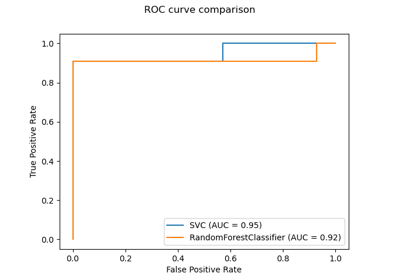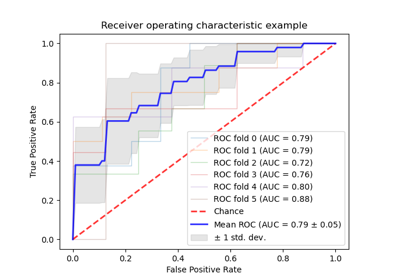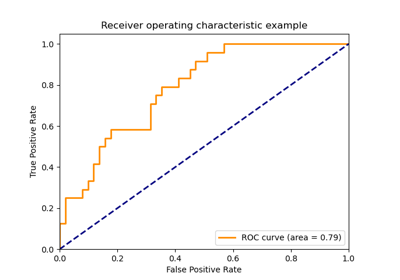sklearn.metrics.roc_auc_score¶
-
sklearn.metrics.roc_auc_score(y_true, y_score, *, average='macro', sample_weight=None, max_fpr=None, multi_class='raise', labels=None)[source]¶ Compute Area Under the Receiver Operating Characteristic Curve (ROC AUC) from prediction scores.
Note: this implementation can be used with binary, multiclass and multilabel classification, but some restrictions apply (see Parameters).
Read more in the User Guide.
- Parameters
- y_truearray-like of shape (n_samples,) or (n_samples, n_classes)
True labels or binary label indicators. The binary and multiclass cases expect labels with shape (n_samples,) while the multilabel case expects binary label indicators with shape (n_samples, n_classes).
- y_scorearray-like of shape (n_samples,) or (n_samples, n_classes)
Target scores. In the binary and multilabel cases, these can be either probability estimates or non-thresholded decision values (as returned by
decision_functionon some classifiers). In the multiclass case, these must be probability estimates which sum to 1. The binary case expects a shape (n_samples,), and the scores must be the scores of the class with the greater label. The multiclass and multilabel cases expect a shape (n_samples, n_classes). In the multiclass case, the order of the class scores must correspond to the order oflabels, if provided, or else to the numerical or lexicographical order of the labels iny_true.- average{‘micro’, ‘macro’, ‘samples’, ‘weighted’} or None, default=’macro’
If
None, the scores for each class are returned. Otherwise, this determines the type of averaging performed on the data: Note: multiclass ROC AUC currently only handles the ‘macro’ and ‘weighted’ averages.'micro':Calculate metrics globally by considering each element of the label indicator matrix as a label.
'macro':Calculate metrics for each label, and find their unweighted mean. This does not take label imbalance into account.
'weighted':Calculate metrics for each label, and find their average, weighted by support (the number of true instances for each label).
'samples':Calculate metrics for each instance, and find their average.
Will be ignored when
y_trueis binary.- sample_weightarray-like of shape (n_samples,), default=None
Sample weights.
- max_fprfloat > 0 and <= 1, default=None
If not
None, the standardized partial AUC [2] over the range [0, max_fpr] is returned. For the multiclass case,max_fpr, should be either equal toNoneor1.0as AUC ROC partial computation currently is not supported for multiclass.- multi_class{‘raise’, ‘ovr’, ‘ovo’}, default=’raise’
Multiclass only. Determines the type of configuration to use. The default value raises an error, so either
'ovr'or'ovo'must be passed explicitly.'ovr':Computes the AUC of each class against the rest [3] [4]. This treats the multiclass case in the same way as the multilabel case. Sensitive to class imbalance even when
average == 'macro', because class imbalance affects the composition of each of the ‘rest’ groupings.'ovo':Computes the average AUC of all possible pairwise combinations of classes [5]. Insensitive to class imbalance when
average == 'macro'.
- labelsarray-like of shape (n_classes,), default=None
Multiclass only. List of labels that index the classes in
y_score. IfNone, the numerical or lexicographical order of the labels iny_trueis used.
- Returns
- aucfloat
See also
average_precision_scoreArea under the precision-recall curve
roc_curveCompute Receiver operating characteristic (ROC) curve
References
- 1
- 2
- 3
Provost, F., Domingos, P. (2000). Well-trained PETs: Improving probability estimation trees (Section 6.2), CeDER Working Paper #IS-00-04, Stern School of Business, New York University.
- 4
Fawcett, T. (2006). An introduction to ROC analysis. Pattern Recognition Letters, 27(8), 861-874.
- 5
Examples
>>> import numpy as np >>> from sklearn.metrics import roc_auc_score >>> y_true = np.array([0, 0, 1, 1]) >>> y_scores = np.array([0.1, 0.4, 0.35, 0.8]) >>> roc_auc_score(y_true, y_scores) 0.75



